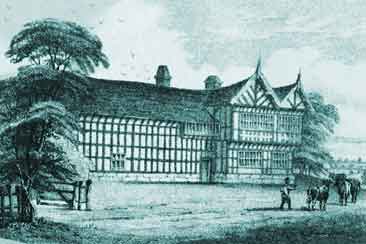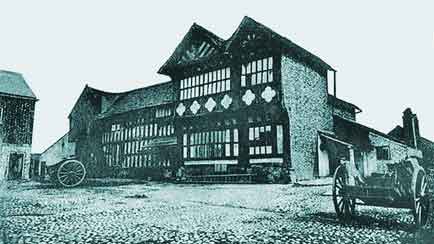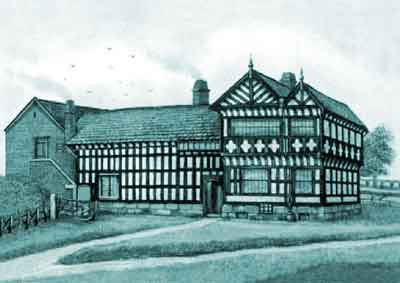Windmill Ln, Denton
This timber-framed manor house, which is believed to date from the late 15th century, was situated off the south side of Windmill Ln.
The Denton branch of the de Holland family, who were descended from the de Denton family on the female side, built the hall and there is a possibility that the de Denton family lived in an earlier hall
either on the same site or nearby.
The male line of the Holland family died out in 1684 and the hall then passed by marriage to the Egerton family who were to become the Earls of Wilton.


Right: Denton Hall, pre-1894. The west wing of the hall (two gables) was demolished in 1894.
In the mid-1850s the historian, Revd John Booker BA MA FSA, recorded that the hall was still in good condition and a painting of it in 1880 by the renowned watercolour artist, Evacustes A Phipson, (Edward Arthur Phipson, b.1854) shows that its condition was still good at this time. Unfortunately, during the last two decades of the 19th century its condition deteriorated. Around this period it ceased being used as a residence to become a farmhouse and the surrounding land became a farm estate. Tenant farmers neglected the hall to such an extent that it fell into a poor state of repair. In 1894, Seymour John Grey Egerton (1839-1898), 4th Earl of Wilton, built a new farmhouse and concurrently the west wing of the hall, with its two gables, was demolished to leave the great hall and east wing, which was leased as a residence.
It continued in this state until the 19 Jan 1930 when the great hall was burned down, to leave only the east wing standing. In 1979 the remains of the east wing were demolished down to the level of its sandstone footings and the surviving timber framing was removed and re-erected at Hough Ln, Wilmslow, Cheshire. There is now no trace of the hall's former existence.

Denton Hall.
It is known to have been extant by 1850 when it was given to the Woolfenden family of hat manufacturers who lived near Denton Hall. Irrespective of the 1618 date, it most likely dates from the late Georgian or early Victorian era. A purdonium is a wooden cabinet with a metal lining to hold the coal. Credit: F Brown.
The Earls of Wilton
Thomas Egerton1st Earl of Wilton (14 Aug 1749-23 Sep 1814). He was a Denton landowner and a major subscriber to the
Manchester, Bolton and Bury Canal Company. He leased two thirds of the land he owned in Denton to the Fletcher and Woodiwis families. Earl of Wilton, 1801-1814.
Thomas Grosvenor Egerton2nd Earl of Wilton GCH PC (30 Dec 1799-7 Mar 1882). Earl of Wilton, 1814-1882.
Arthur Edward Holland Grey Egerton3rd Earl of Wilton (25 Nov 1833-18 Jan 1885). Earl of Wilton, 1882 -1885.
Seymour John Grey Egerton4th Earl of Wilton (1839-1898). Earl of Wilton, 1885-1898.
Arthur George Egerton5th Earl of Wilton (1863-1915). Earl of Wilton, 1898-1915.
Seymour Edward Frederic Egerton6th Earl of Wilton (1896-12 Oct 1927). Earl of Wilton, 1915-1927.
Seymour William Arthur John Egerton7th Earl of Wilton (29 May 1921-1999). Earl of Wilton, 1927-1999.
Francis Egerton Grosvenor8th Earl of Wilton (1934-). Earl of Wilton, 1999-).
Julian Francis Martin Grosvenor, Viscount Grey de WiltonHeir apparent.
Names in the Holland, Egerton and Wilton families commemorated in Denton
Catherine St (Lady Katherine Egerton, 1835-1920)
Egerton St
Elizabeth St (Lady Elizabeth Egerton, 1832-1892)
Grey St
Grosvenor St
Heaton St
Holland St
Seymour St
Wilton Grove
Wilton St
Wilton Arms public house (demolished in 1968)
Further Reading
Middleton, Thomas, 1936. History of Denton and Haughton. Hamnett St, Hyde: J Andrew & Co Ltd.
Holland, Bernard, 1917. The Lancashire Hollands, pp. 269-284. Albermarle St, London: John Murray.
Farrer, William & Brownbill, J (eds.), 1911. A History of the County of Lancaster, Townships: Denton, pp. 311-322, Vol. 4. London: Victoria County History.
